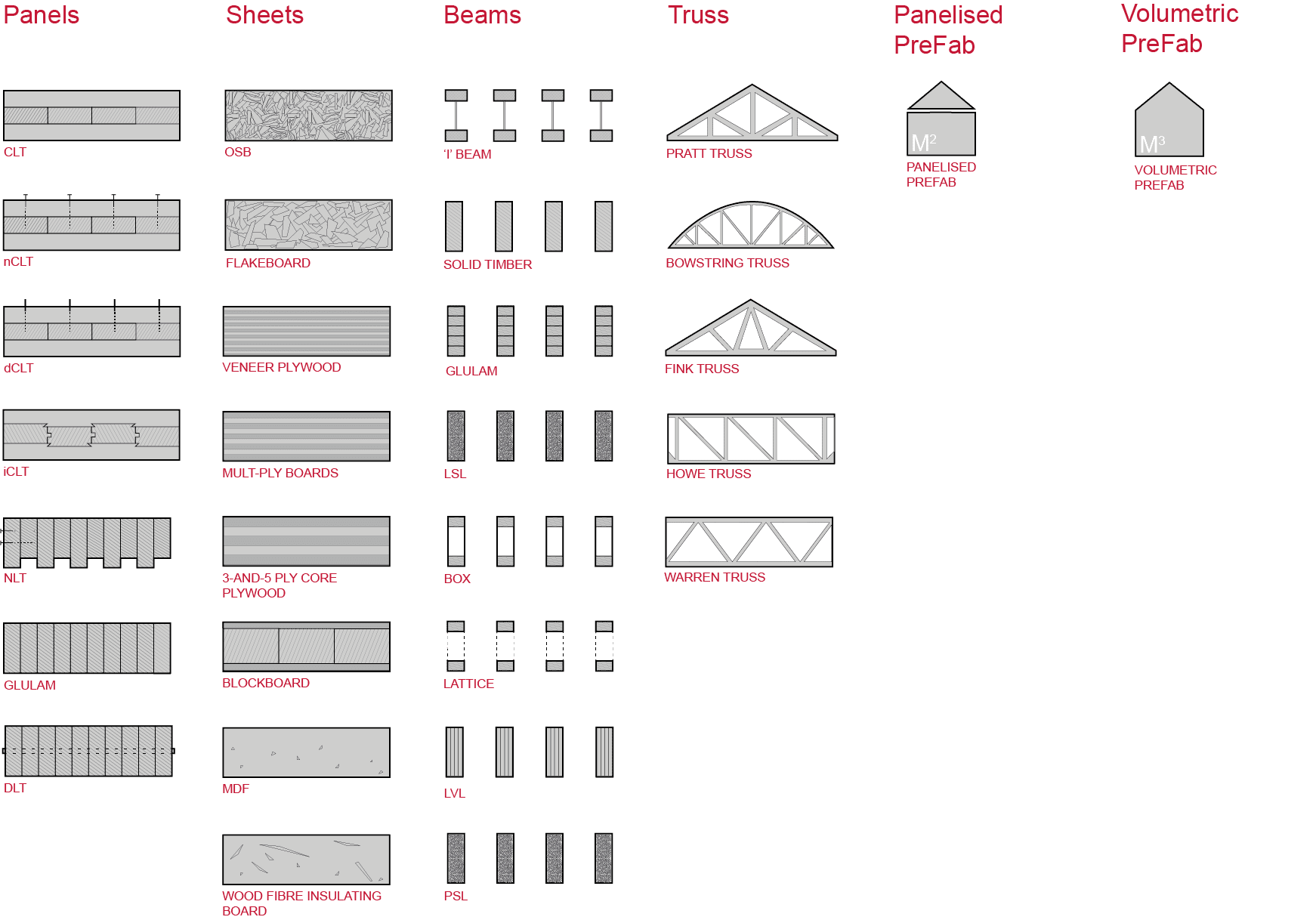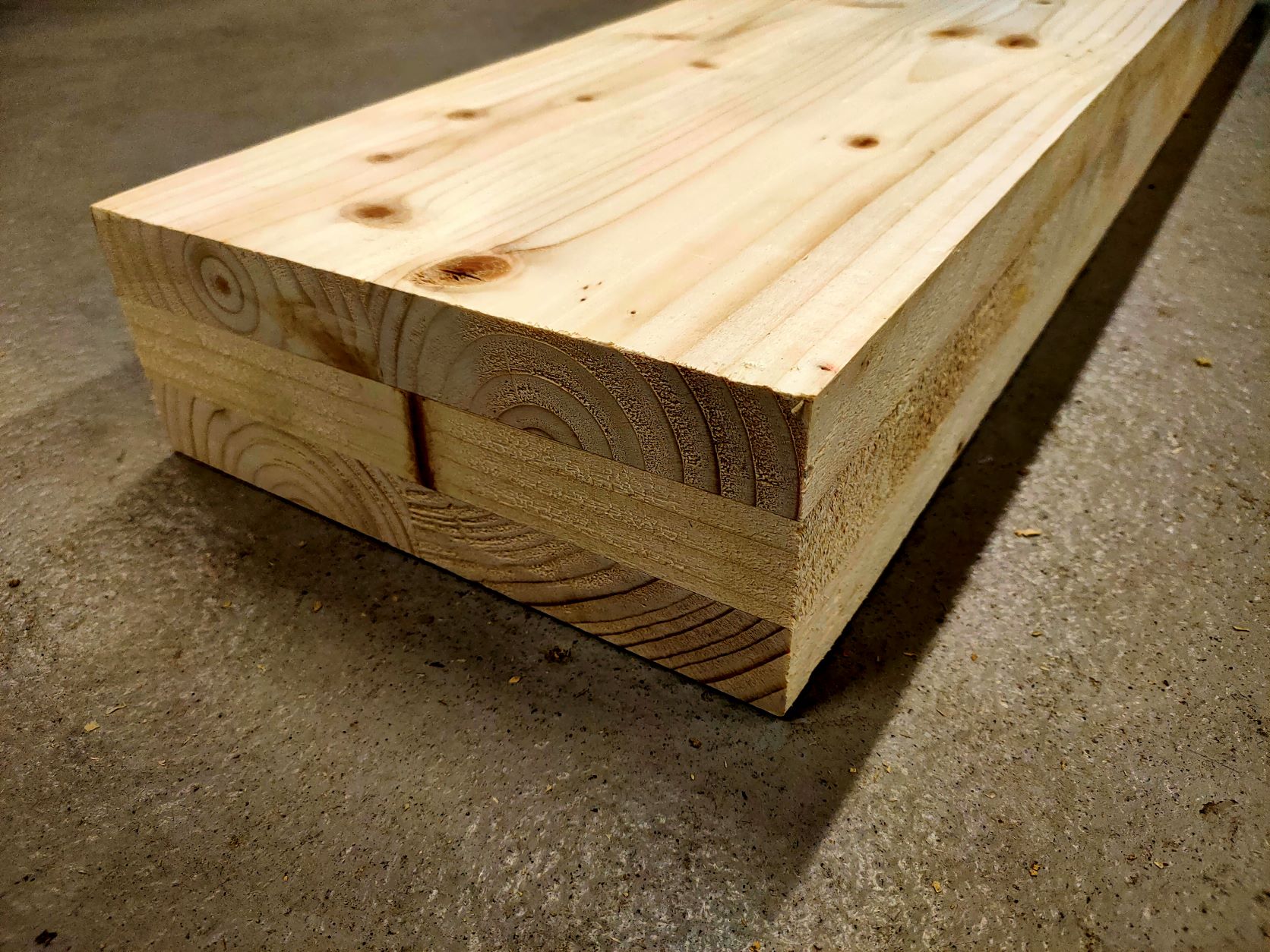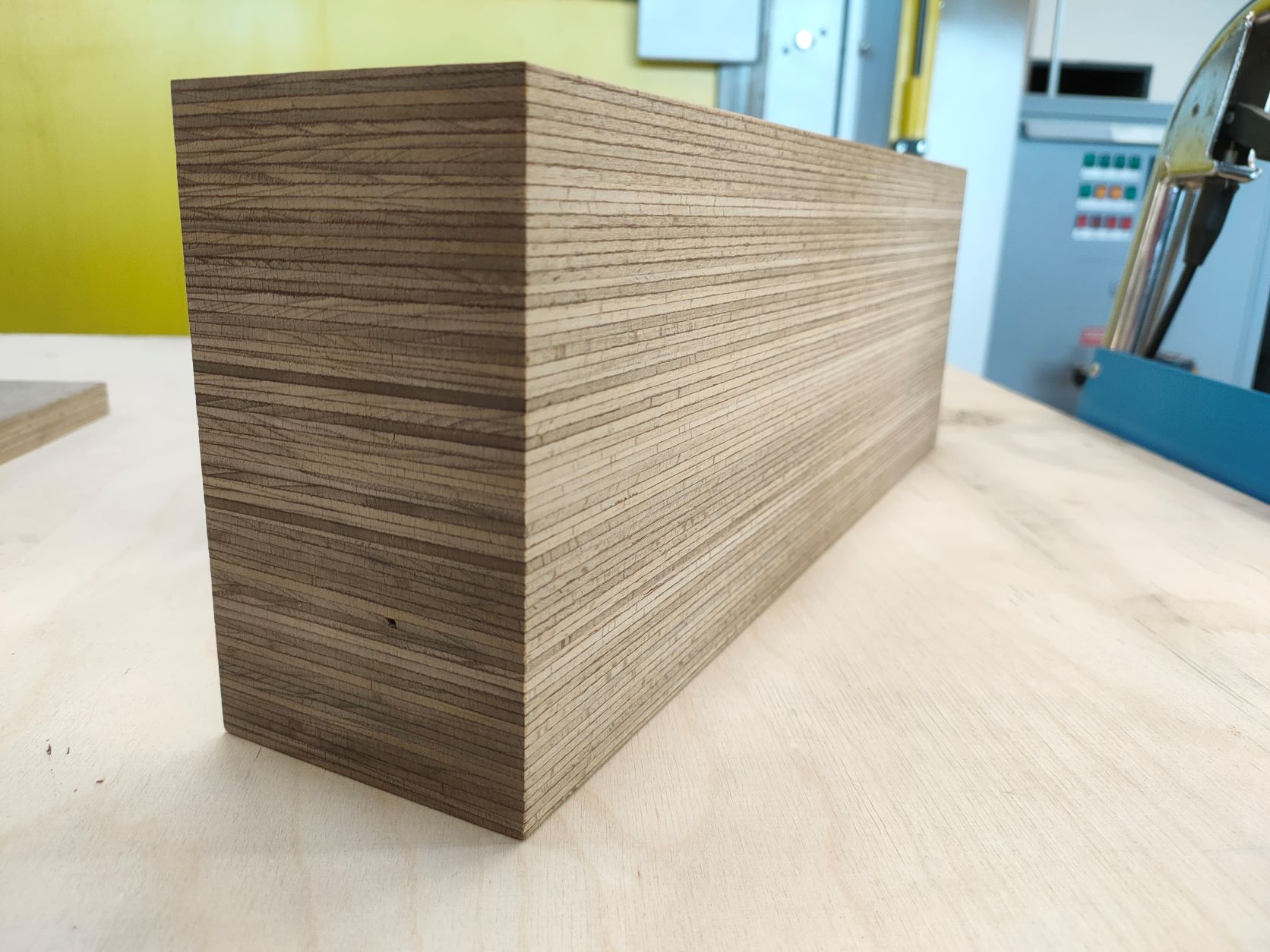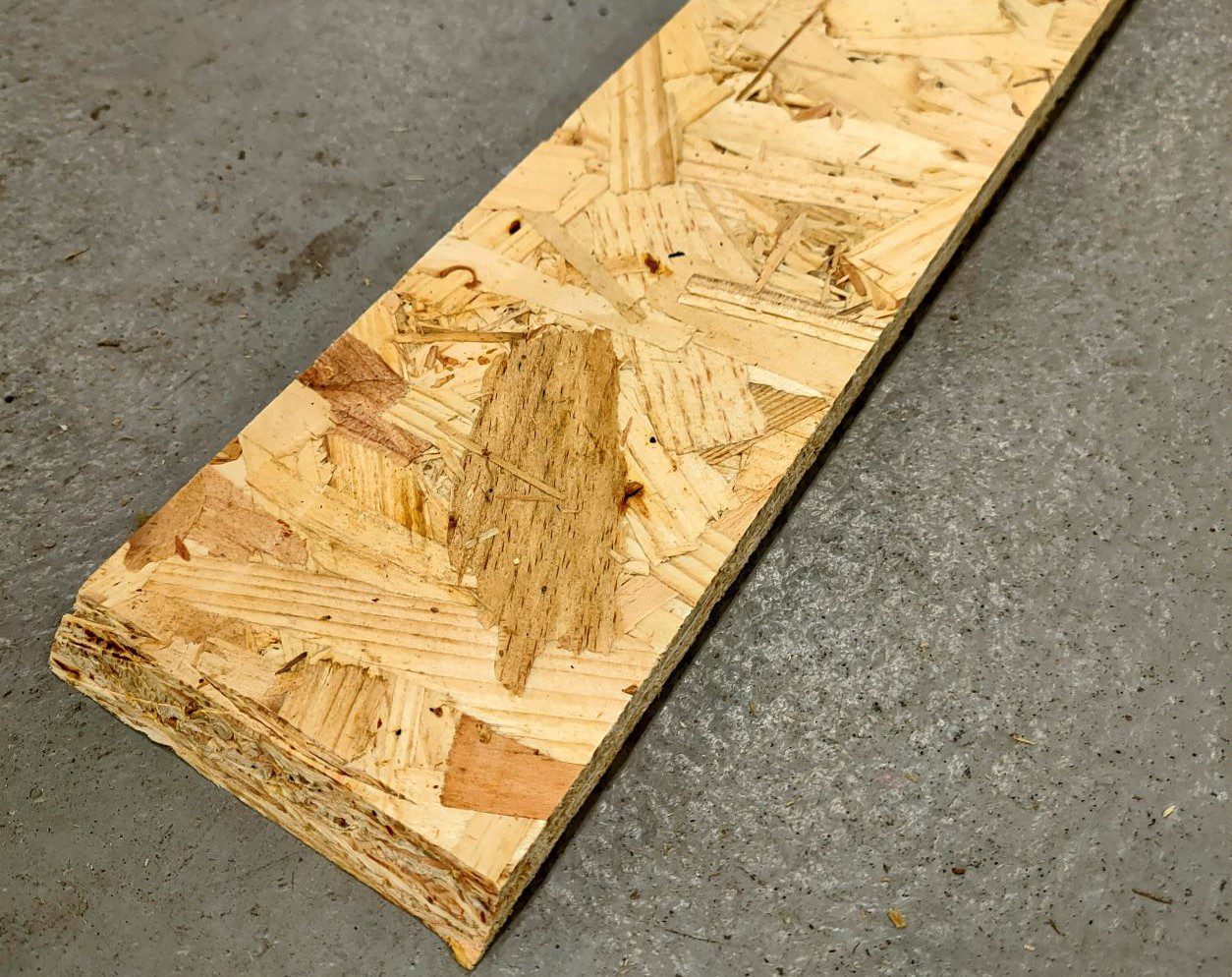
The text for this post is written by Wojciech Plowas (I only rearranged it). The beautiful overview image above was created by Ben Shirley from NMITE.
Sawn timber, due to its high strength to weight ratio, durability, ease of handling and environmental credentials, has become an increasingly popular construction material. Timber, however, is a natural material, and as such it comes with certain limitations in the scope of applications. These include maximum cross sections and lengths available on the market (the tree can only grow so wide and so long), the presence of naturally occurring defects and dimensional stability. To overcome these limitations, architects and engineers have developed various ways of connecting series of smaller timber planks, chips or veneers together to form larger timber elements. For the purposes of this article, EWPs can be split in 3 groups:
- Mass Timber – dried planks of wood glued or fixed together to form laminated timber.
- Wood-based panels – veneered, chipped or sliced logs bonded together forming panels.
- Wood composites – structurally efficient composite systems.
There are other categories of engineered wood products, such as chemically and thermally modified woods, but here we are focusing on the most common types of large structural products.
Mass Timber
The term Mass Timber can be described as the family of Solid Laminate Timber Systems produced by connecting a series of smaller timber elements to form larger panel or beam products. Various forms of Solid Laminate Timber Systems are available today. These include systems that are glued, such as Cross Laminated Timber (CLT), Glue Laminated Timber (GLT), Laminated Veneer Lumber (LVL) and those that are non-glued, such as Nail Laminated Timber as well as others that use moisture movement for connectivity such as Dowel Laminated Timber and interlocking Cross Laminated Timber.
CLT

Cross laminated timber is manufactured from timber boards which are glued in perpendicular layers under high pressure, either mechanically pressed or in a vacuum bag to form a planar product to be used as framing, walls, floors, roof or core structural elements. In the factory the cross-laminated solid timber panels can be cut to the required shape and size. Further to this, routing and holes for services and connections can easily be incorporated within the panels. Panels are shipped to site and assembled rapidly with metal fasteners.
GLT
Glue laminated timber, commonly referred to as GLT or Glulam, comprises a number of layers of dimensioned timber (lamellas) bonded together using structural adhesive with the direction of the lamellas parallel to the longitudinal axis of the element. Lamella dimensions vary according to the final specification and end use of the product, however the individual lamella thickness typically ranges between 19mm and 50mm. It is common practice during commercial GLT production to visually assess individual lamellas for (strength reducing) defects which are removed via cross-cut. Following this, the lamellas are then finger-jointed together in order to produce the desired length.
LVL

Laminated veneer lumber (LVL) is an engineered wood product made of 3 mm thick veneers bonded together with weather-resistant phenolic adhesive. This means that the dimensions of the final LVL product are not limited by the dimensions of the raw material, and even small-diameter logs can be used to produce large LVL beams and panels. When veneer logs are peeled to produce veneer, any natural defects in the wood, such as knots, are dispersed as small fragments across the veneer. Due to the lack of sizeable defects, the strength to weight ratio of LVL is extremely high – LVL is twice as strong as steel in proportion to weight.
Wood based panels
Plywood
Plywood is a flat panel made by bonding together, and under pressure, a number of thin layers of veneer, often referred to as plies (or laminates). Plywood was the first type of EWP to be used at industrial scale. Logs are debarked and steamed or heated in hot water for about 24 hours. They are then rotary-peeled into veneers of 2–4 mm in thickness and clipped into sheets of some 2 m wide. After kiln-drying and gluing, the veneers are laid up and bonded under pressure. Plywood uses an odd number of laminates (at least three) that are bonded with perpendicular grain orientation. The outside plies, always made of veneer, are referred to as faces (face ply or back ply) and the inner laminates, which could be made of either veneers or sliced/sawn wood, are called core. Plywood is produced in many countries from either softwood or hardwood or a combination of both.
Oriented Strand Board

OSB is an engineered structural board manufactured from thin wood strands, flakes or wafers sliced from small-diameter round timber logs and bonded with an exterior type adhesive (comprising 95% wood, 5% resin and wax) under heat and pressure. OSB panels comprise exterior or surface layers that are composed of strands oriented in the long panel direction, with inner layers comprising randomly oriented strands. Their strength is mainly due to their multi-layered make-up and the cross-orientation of the strands. The use of water and boil-proof resins/adhesives provide strength, stiffness and moisture resistance.
Particle and fibre boards
Particle and fibre composites are usually available in panel form and are widely used in housing construction and furniture manufacture. There are several products in this category and all are processed in a similar way. Examples include high-density fibreboard, medium-density fibreboard, tempered hardboard, cement-bonded particleboard, etc. For fibreboards, chips are refined to wood fibres by the aid of steam and then dried and adhesive is added to form a mat of wood particles and pressed until the adhesive is cured. After cooling the boards are cut to the required sizes.
Timber composites
Thin webbed joists (I-joists)

I-joists are structurally engineered timber joists comprising flanges made from solid timber or LVL and a web made from OSB, plywood or particleboard. The flanges and web are bonded together to form an I-section member, a structurally efficient alterative to conventional solid timber. I-joists are economical and versatile structural elements in which the geometry permits efficient use of material by concentrating the timber in the outermost areas of the cross-section where it is required to resist the stresses. I-joists are lightweight and can easily be handled by one or two persons, they generally possess higher strength and stiffness than comparable-sized solid timber, resist shrinkage, warping, splitting and checking, and are more efficient than solid timber for large spans and loads. They can be used as structural framing in floors, walls and in flat and pitched roofs.
Thin webbed beams (Box beams)
Box beams comprise solid timber, LVL or glulam flanges with plywood or OSB webs. The webs are generally glued to the flanges on each side to form a box shape. Machine driven nails/staples can be used to aid fabrication. Similar to I-joists, the larger parts of the cross-section (flanges) of box beams are at the top and bottom where the flexural stresses are highest. Plywood box beam showing veneer on its webs can be used as part of the aesthetic finish as well as the structure. The hollow cross-section of the box profile also permits services to be run in the void inside the member giving a cleaner finish. It also gives the member torsional rigidity, which makes it more able to resist lateral torsional buckling or stresses due to eccentric loads.
